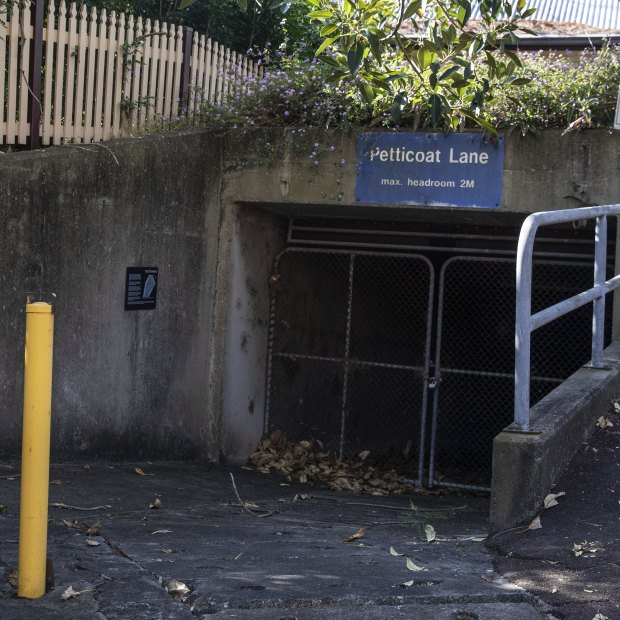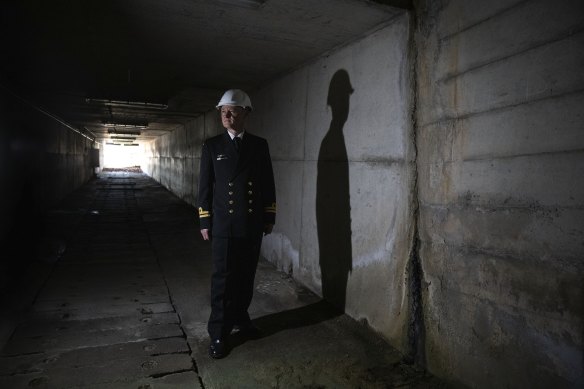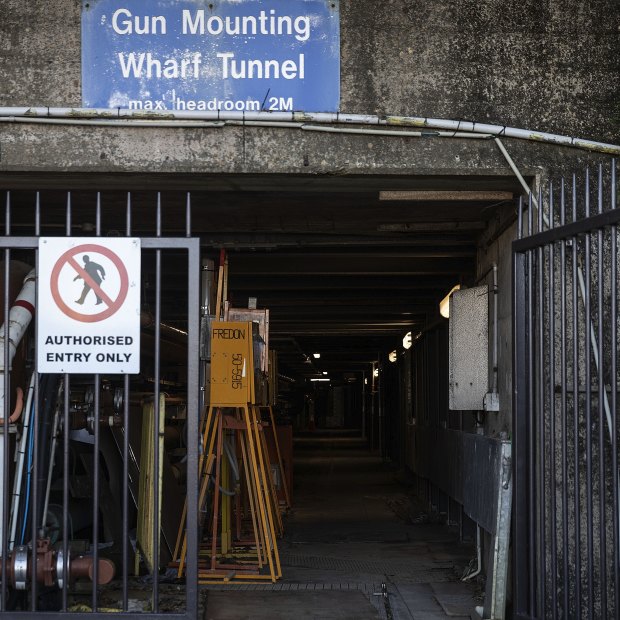A labyrinth of World War II tunnels under Garden Island appears as ready today as it was when first excavated in a hurry more than 80 years ago.
The base’s underground network was dug out of sandstone starting in 1941 after the Japanese attacked Pearl Harbour.

The entrance to the Petticoat Lane tunnel under Garden Island.Credit: Jessica Hromas
There were fears that an aerial attack on Sydney could follow, and the five tunnels would provide an air-raid shelter for the 2500 or so essential dockyard staff based at Garden Island.
There was no room for the public. They could take their chances in the railway stations.
The tunnels, some with evocative names such as Petticoat Lane, North-West Passage and Lambeth Walk, have just been serviced as part of a multimillion-dollar three-year infrastructure upgrade at the defence base.
The wharves where warships dock have been modified, a fuel tank for the ships replaced as well as improvements to the island’s infrastructure (fuel electricity, sewerage and water), much of which runs through the tunnels.

Lieutenant Brendan Trembath in the Petticoat Lane tunnel under Garden Island. Credit: Jessica Hromas
Even on a warm day, it is cool inside Petticoat Lane (named after a fashion and clothing market in Spitalfields, London) which is concrete-lined with recesses cut into the rock for stretcher-bearers, casualty clearing stations, washrooms and toilet facilities.
There’s a slight echo and one end is sealed off with warning signs not to enter due to asbestos, once used to insulate boilers and pipes on ships.

The entrance to Gun Mounting Wharf Tunnel, under Garden Island.Credit: Jessica Hromas
Colin Randall of the Naval Historical Society of Australia, who grew up on Garden Island, said the minister for the navy at the time, previous prime minister Billy Hughes, did not want to frighten people by making them think Sydney was going to be under attack.
Hughes simply ordered 100 tin hats for the air raid wardens and some training for them in case of a gas attack.
“But the defining moment, of course, was the attack on Pearl Harbour. That clearly brought to the Australian shore [the belief that] we were going to be a target.”
The Japanese attacked Pearl Harbour on December 7, 1941, and four days later excavation commenced on the tunnels, originally to accommodate 1400 people.

Advance of the Japanese prompted tunneling for air raid protection at Garden Island.
Randall said the intention was that the tunnels would enable the workers on Garden Island to be protected from 70 tonnes of bombs dropped in a period of 24 hours.
The financial certificate dated December 30, 1941, to provide a system of tunnels was approved at an estimated cost of £15,150. Then, like now, there was a cost overrun.
The need for protection from air attack became even more apparent when the Japanese dropped more bombs on Darwin on February 19, 1942, than they did at Pearl Harbour.
Then at the end of May in 1942 three Japanese midget submarines succeeded in entering the harbour.
One attempted to torpedo the heavy cruiser USS Chicago, but instead hit the Royal Australian Navy depot ship Kuttabul, which quickly sank with the loss of 21 Allied sailors.
Naval Historical Society of Australia president David Michael said there was a Japanese flyover two days before the midget submarine attack, but no one recognised it.
“At that time all the houses had blackout curtains, but work on the dry dock was going on 24/7, so it was floodlit and the night of the attack any ships in the harbour were beautifully floodlit from behind. The priority was to get the dry dock built.”
By the 1960s the tunnels had been abandoned and the timber sets for roof support had either rotted out or been eaten by termites. In the 1970s the tunnels were upgraded with new steel roof supports and concreted where the soft sandstone walls had weathered. The tunnels are used for storage.
The Garden Island infrastructure recovery project will cost half a billion dollars and is expected to be completed by the end of the year.


